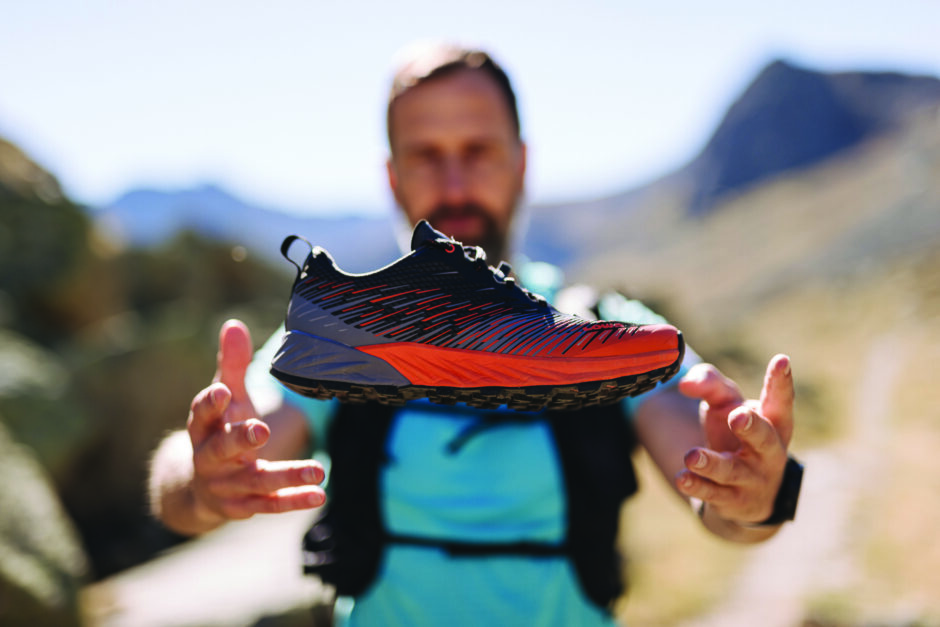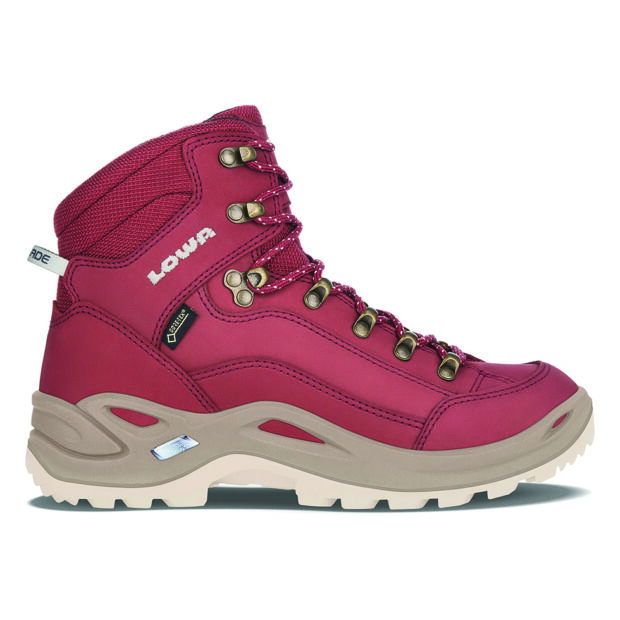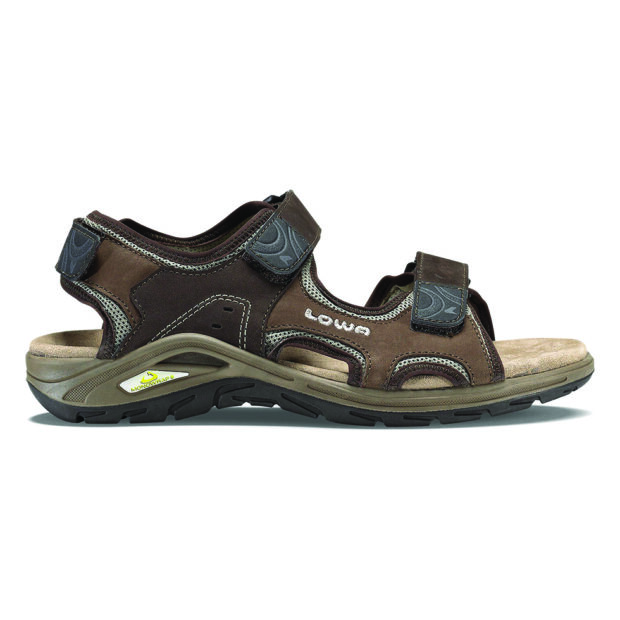
When it comes to Lowa Boots, no one is a more dedicated student of the brand—and the market it serves—than General Manager Peter Sachs. That’s because Sachs has spent his entire 47-year career working in the outdoor sports industry and the past 27 years at the helm of Lowa Boots. In fact, he is employee No. 1 of the German brand’s Greenwich, CT-based U.S. outpost and largely responsible for guiding Lowa on its path to becoming a specialty market leader here. It’s been a steady climb, one that has enabled Lowa to get acclimated at each new level before ascending to the next. Sachs has always held the brand’s long-term health top of mind. There have been no detours off the trail with misguided category extensions or chasing short-term sales bumps at the expense of more stable, longer-term growth. Indeed, the key to Lowa’s longevity is consistency in its product, people, and passion for the outdoors.
“The people who’ve owned and managed the brand have always had a very consistent business plan,” Sachs says, praising the founding Wagner family followed in 1993 by the Zanata family for their even-keel approach. “That plan has always been: Let’s make our product in Europe, using the best-quality materials and state-of-the-art constructions, and sell consistently at full price and not be discounting every day.”
The consistency, Sachs says, has enabled Lowa to capitalize on great years and weather downturns, avoiding huge roller coaster rides. “Even in 2020 when everybody took a hit, it wasn’t a big hit for us because of our consistent business plan,” he says, noting that the following two years saw healthy growth. “We had about a 30 percent increase in sales in 2021 and maintained it in 2022, and if we can get our inventory under control, we’ll end up with an increase in the mid- to high-single digits this year.”
Looking out five years, Sachs says the goal is to grow the business by at least 50 percent. He’s quite “bullish” on reaching that number, thanks to a growing overall outdoor category, market share gains, and new product introductions. These include the brand’s entry into the trail running category and its new tactical boot, the Zephyr MK2, this year, followed by the latest update to its No. 1-selling Renegade boot next year. “Having a really stable business gives us the platform to keep bringing new products to market, and that gives us opportunities to open some doors as well as to sell more pairs within existing shelf space, all of which adds up,” he says.
Sachs knows full well that another owner could have charted a far different path for Lowa. “A venture capital firm or public company could have set expectations that might have been achievable one year, but then the economy could have gone south, or there would have been an interruption, like the pandemic or a war like in Ukraine, and it would no longer have been sustainable,” he explains. “Suddenly, the business plan would have been put on the shelf and we’d have needed to make those numbers, so maybe we’d have cut prices so we could sell X amount more units…and then it becomes a roller coaster. We work hard to avoid those ups and downs, which I think is rare in this business.”
Another rarity is sticking to select retail channels and, more notably, standing by individual accounts, regardless of their order sizes. “We haven’t cut off that specialty dealer who may only buy 40 to 50 pairs a year,” Sachs says. “We’ve stayed true to those dealers through good years and bad years.”
Outdoor Sports Center in Wilton, CT, is one such longtime Lowa dealer. Arlo Tarr, footwear buyer for the past 11 years, says the relationship stretches back well before his time. “I’m guessing it’s 30 years or maybe longer,” he says. “And I worked at Diamond Brand Outdoors in North Carolina prior, and it was the same there.” Tarr credits Lowa’s “phenomenal” quality for its longevity. “Their boots break in the easiest,” he says, citing the Renegade as its best-seller for years. “Renegades are never returned for warranty or fit issues, and Lowa makes them in narrows and widths and doesn’t change them often, which customers love. They come back and say, ‘Hey Arlo, I’m ready for another size 10’ and boom, done.” Tarr adds, “Our customers know that if you buy Lowa, you’re getting the best of the best in hiking footwear.”
Jeff Langner, CEO of Morgan Shoes in Madison, WI, concurs on Lowa’s unsurpassed quality, having stocked the brand for 24 years. As a certified pedorthist, he loves recommending Lowa, particularly the Renegade and Innox light hiker, to customers. “They’re good for you!” he says, noting that the excellent grip soles are ideal for the area’s slippery winter conditions. “Plus, their use of PU vs. (EVA): One feels good today, the other feels great for years.” Langner describes the Innox hiker as a “great walking shoe” and a step up from other brands. “The rocker bottoms work to easily move forward with little effort and offer control vs. squishier options,” he says. “And they last longer, are waterproof, and made in Europe, where they’ve been making great shoes for 100 years.”
Count REI and Zappos as two more longtime, loyal Lowa accounts. Tad Summersett, REI’s merchandise manager for footwear, says the co-op has carried the brand for decades. “The foundation of our relationship is built on mutual respect for quality and customers,” he says. “Lowa consistently provides REI members with premium quality product that can be trusted to last for many adventures. It’s a part of their DNA and shows up in all the products they build.”
Bill Johnson, senior outdoor footwear buyer for Zappos, says the site has carried Lowa since 2006. Perennial best-selling styles include the men’s Renegade GTX Mid in sepia and the women’s version in stone, as well as the Zephyr Desert Mid tactical boot in stone. “Lowa attracts the core outdoor enthusiast who has a passion for the backcountry,” he says, adding the keys to the brand’s longevity are “outstanding quality, fit consistency, and a dedication to exceeding the consumer’s needs.”
Staying the Course
It’s not like Sachs hasn’t had opportunities to land juicy orders from beyond the specialty sphere. Some, he confesses, have been quite tempting. “You look and say, ‘Oh my God, they have X number of storefronts and sell X number of units…let’s make that happen.’ But the reality is we might hit those numbers for a year or two and then, when outdoor isn’t hot as a category, they’ll move on to the next big thing and we’ll be left at the curb and won’t be able to go back to the retailers we will have lost.” Sachs adds, “Our goal is to be here the next 10, 15, and 100 years. It’s better to have that stable business instead of that roller coaster ride.”
Sachs walks the walk. Mid last decade he added Amazon to its account base only to walk away from the business about two years later, in 2017. That’s despite Amazon amounting to about 10 percent of Lowa’s overall sales at the time. Why? “We found that Lowa was on sale somewhere all the time,” he says. “It wasn’t worth having our other dealers calling me all the time saying they had to price match what they saw on sale on Amazon. So we cut them and told all of our dealers to stop selling on Marketplace, too.”
It wasn’t an easy decision to forego a sizeable chunk of existing sales. Amazon even flew a team of buyers to Greenwich in an effort to maintain the partnership. “It’s a big number, and our owners were a little nervous that I was walking away from that business,” Sachs admits. “But we had that percentage back within eight or nine months. More importantly, it just brought peace back under our roof, and there had been no peace for a while.”
Again, the overriding concern behind this decision was Lowa’s long-term health. “I just knew that the day would come if we’d kept selling Amazon that they’d become such a big part of our business that one day I’d basically find Jeff Bezos sitting on our doorstep offering $1 for our company because if Amazon were to stop doing business with us, our company would be only worth $1,” Sachs says. He refused to let Lowa succumb to such a fate. In fact, Lowa’s U.S. sales have more than doubled since the divorce.
Was this the best business decision of Sachs’ career? It ranks near the top—along with his decision to exhibit at the Shot Show about 18 years ago. That’s where Sachs got Lowa into the tactical boots channel, which now accounts for 20 percent of total sales. As Sachs recalls, the Shot Show was held at the same time as the ski show in Las Vegas, so he decided to take a look. “It hit me right away that everyone there—be it military, law enforcement, or hunters—all wore boots,” he says. “I thought, we’ve got to be here. The next year we had a 10×10 booth in the last row of the convention center, which was in Orlando.”
Tactical has been a steady, reliable growth category ever since. “It’s become a great business,” Sachs reports. “We opened dealers during that first show that are still customers today.” He adds that while outdoor and tactical are separate businesses, some products cross over, albeit with slight modifications that cater to unique needs. “We’ve made some outdoor boots in black or coyote and changed the hooks to closed eyelets because uniform customers don’t want it to snag on their gear,” he explains. “We’ve also certified boots to be slip- and chemical-resistant to enable them to best perform their jobs. As always, our goal is to pay attention to the details in order to make the best quality products that we can.”
Hitting the Trail Running
Lowa doesn’t enter new categories willy-nilly. Its design team takes a methodical approach that can be years in the making. The entrance into trail running with its All Terrain Running (ATR) collection this year is no exception. While that might seem like a relatively small leap for an outdoor brand, Sachs says Lowa is determined to offer unique product that performs at the high levels its customers expect. Hence, the three-year effort leading up to the June debut of ATR.
Specifically, Lowa incorporated performance attributes found in its boots into ATR without adding bulk. “Our lighter, multi-density EVA midsoles are much like the multi-density PU that we use in almost everything else,” Sachs explains. “Then there’s our rebound plate, which is not too dissimilar to the stabilizer that we put into a lot of our boots, plus we’ve added toe and heel protection, and a lighter version PU wrap that we feature in our mountaineering boots adds durability, support, and stability in the uppers.”
The decision to enter the trail running market is also a reflection of the times. “We believe a lot of our customers, or potential customers, are trail running,” Sachs says. “And if they aren’t trail running, they’re wearing a lighter weight shoe for their daily activities, light hikes, and walks.”
Still, there are risks involved. For starters, the collection marks Lowa’s first Asia-based (Vietnam) production as well as its first use of EVA. “PU lasts five to seven times as long and is more sustainable, but you need the softness and rebound ability of EVA for a running shoe,” he says. Sachs believes the risks are worth it because the category should attract new and younger consumers to the brand and open new doors. “It gives us price points that aren’t achievable from our European production and an opportunity to be on the wall at a more entry level,” he says. “We showed it to a select group of accounts at The Running Event last November and received orders from about 30. We’re excited about the reception.”
Sachs foresees plenty of growth potential in the running specialty tier. “Maybe it’s 100 to 150 storefronts, and they don’t have to buy hundreds of pairs each to give us good growth,” he says. “Maybe they’ll buy an outdoor or walking shoe from us as well, because they already have that customer. So, we’re pretty optimistic about the future.”
The goal, however, isn’t to become the next Hoka, Nike, or Adidas, according to Sachs. There are no plans to open large sporting goods dealers or department stores. The plan is to stay in the specialty outdoor, uniform, and now running channels. “There are lots of opportunities there,” he says. In fact, Sachs doesn’t think Lowa will even be up against the major athletic brands any more than it’s up against Merrell in outdoor. “We look to compete against specialty brands, like Scarpa and Altra, in the trail space,” he says. That said, he welcomes mainstream athletic brands into the trail running category. Their collective marketing muscle only makes the category more popular, he says. “Nike has a far greater marketing reach than Lowa ever could. When the tide rises, all the boats in the harbor rise.”



That has proven true in the outdoor market since the pandemic. The category has enjoyed a spike in growth as more people sought the mental and physical rewards of spending time in nature. “Pretty much everybody went for a walk in their local park, or they went to their state park, or a national park,” Sachs says. “Even if they haven’t been hiking, many have been biking, camping, paddling, etc. We’re excited about that because we’re much more likely to get them as a customer than if they’re at home playing computer games. What’s more, a lot of people have kept up with their outdoor activities.” Sachs’ observations are corroborated by the 2023 Outdoor Industry Association study that states overall participation rates grew for the eighth straight year, totaling 168.1 million, or 55 percent of the U.S. population ages six and older. It marks a 14.5 million increase since January 2020.
This customer ranges from weekend warriors to those taking outdoor-oriented vacations involving camping, staying in a cabin, or living the van life. “They’re also active in local trail crews, birding and hiking clubs, and scout groups,” Sachs reports. “They’re just outdoor active, and many tell us this is their second pair of Renegades or Caminos for their cabin, so they don’t have to lug them back and forth.” Another growing customer segment is section hikers, who tackle portions of long trails, like the Appalachian and the Pacific Crest. “They’ll take four or five days to hike 50 to 100 miles increments,” he says. “Teachers and retirees make up a lot of this customer base because they have the time to do those kinds of seasonal trips.”
Sachs has also witnessed a surge in outdoor enthusiasts at his local, 350-acre park. “You can’t get a parking space on weekends. I bike a lot too, and I’ve never seen the roads as busy as they are today,” he says. “If they’re hiking, biking, or just walking their dog, it’s to our benefit.” Remote work has also contributed to the category’s success. “Even some Wall Street firms no longer require suits in the office five days a week. It’s a button-down shirt, khakis, and casual shoes,” Sachs says. “The outdoor pie has grown, and we’ve all grown with it with a couple of really good years.”
The Trail Ahead
For the remainder of this year, Lowa’s primary focus is on celebrating its 100th anniversary. That includes social media to tell the brand story and introducing consumers to its athlete ambassadors. Lowa has also amped up in-store marketing with 100th anniversary POS materials and “tons of schwag” for staff. “We have to remember that store employees are the silent partner in the whole deal,” Sachs says. “They’re the guys and gals who really make it happen, and we have to make sure that they get a little love.”

Similarly, Lowa is giving back extra this year to the many outdoor causes it has long supported. That includes donating a bigger percentage of its website sales to non-profits like Big City Mountaineers, Cornell Lab of Ornithology, American Hiking Society, and Appalachian Mountain Club. Lowa is also taking over a Bavarian mountain town this September, inviting select retailers and consumers to try the latest styles and attend classes run by its ambassadors.
The fact is that milestones of this magnitude are rare, especially when taking into account the disruptions that have happened in the past 100 years. A centennial should be celebrated, and Lowa plans to make the most of it. “We’re proud to have survived wars, recessions, weather events, pandemics…you name it,” Sachs says. “It really is an incredible accomplishment.” Sachs singles out Lowa’s people, the caretakers, for guiding the brand through the many challenges. He’s proud to be one of those caretakers. It’s a responsibility he doesn’t take lightly. “I’m an arbiter on whether our product and messaging are right. Does it properly reflect our brand, or did we go off-trail? Do our athlete ambassadors reflect Lowa values, or are they just some hotshots who climb really well?”
In the case of Lowa ambassador Carlos Buhler, the brand fit is perfect. The expert climber—one with several Himalayan first ascents under his belt—stopped climbing recently in order to focus on the needs of others. Seeing climbing as a luxury in a time of war, Buhler went to work in soup kitchens along the Polish border to help feed Ukrainian refugees. He met a heart surgeon there and has since been reaching out to doctors in the U.S. to send medical equipment to Ukraine. Sachs has offered Lowa’s warehouse as a transit point for those shipments free of charge. “I’m fortunate to deal with people who have a lot of character,” Sachs says. “I think Carlos’ actions reflect those of our brand.”
Sachs has earned equal praise within the outdoor industry. Zappos’ Johnson says the first word that comes to mind when thinking of Sachs is trust. “Peter has built our relationship through open communication, acting reliably, sharing common goals, and fostering a sense of collaboration and respect,” he says. “He consistently demonstrates integrity with confidentiality and navigates challenges with us, laying the foundation for long-term success and mutual growth.” On a personal level, Johnson describes Sachs as a mentor. “He’s a knowledgeable resource who has helped me grow over our 17-year partnership,” he says. Tarr of Outdoor Sports Center concurs on Sachs’ solid mentoring skills. “He gives great advice on growing our business. I trust his insight,” he says, noting Sachs is a frequent visitor to the store. “I love talking about the outdoor industry with him. He’s always on the pulse of what’s happening.”
To that end, Sachs says Lowa’s main focus is on the trail ahead, be it launching new products or finding fresh ways to support the industry. “It’s really just as important as the past 100 years to say to our retailers and consumers that our goal is to be here for the next 100 years.” •



